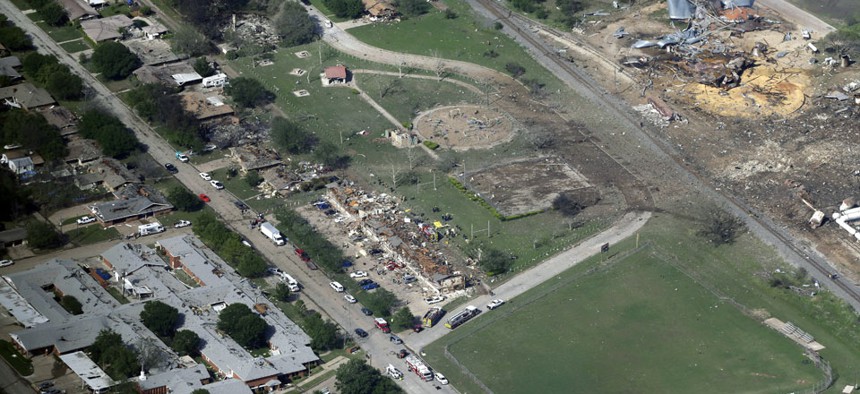
The remains of a nursing home, left, apartment complex, center, and fertilizer plant, right, destroyed by an explosion at a fertilizer plant in West, Texas. Tony Gutierrez/AP File Photo
Federal Report: Regulatory Confusion Contributed to Texas Chemical Disaster
U.S. Chemical Safety Board releases preliminary findings from investigation.
Before violently exploding and killing 14 people last April, a Texas fertilizer plant first fell through multiple regulatory loopholes -- some real and some likely imagined, a federal advisory panel says.
In a release of some preliminary findings from its investigation into the incident this week, the U.S. Chemical Safety Board noted that under federal law, companies must report the use of chemicals that the Environmental Protection Agency considers to be "extremely hazardous substances."
Ammonium nitrate, the substance believed to have caused the deadly 2013 blast, along with some other industrial explosions in recent years, is not on the EPA list, however, the board noted. The board is an independent federal body that investigates chemical incidents and advises regulatory agencies.
The West, Texas, facility did give notice of its use of ammonium nitrate -- under a separate requirement by the same federal Emergency Planning and Community Right-to-Know Act to report the use of those substances deemed "hazardous chemicals" by the Occupational Safety and Health Administration.
But state officials, who are responsible for enforcing the law in Texas, determined -- incorrectly, according to EPA guidelines -- that the facility was exempt from the statute's requisite emergency-planning requirements, the board says.
"This disconnect between the federal and state agencies played a significant role in the lack of emergency planning at West Fertilizer, which left emergency responders and residents unprepared for what occurred on April 17," the board says in a presentation made in the Texas town on Tuesday. "The [board]'s investigation will attempt to address this issue in our final report."
The EPA risk management program -- a separate initiative established under the Clean Air Act -- demands that companies using certain chemicals take steps to prevent accidents from happening in the first place. However, ammonium nitrate is not covered under this program, either.
Following the West disaster, Senator Barbara Boxer (D-Calif.), who chairs the Senate Environment and Public Works Committee, urged the agency to adopt a 2002 Chemical Safety Board recommendation to include the substance in the program, but it is unclear how the agency is responding to that request.
Boxer spokeswoman Kate Gilman on Wednesday declined to say whether the agency had complied with the senator's demand for a response by July 2013 regarding the status of the request. EPA spokeswoman Enesta Jones did not reply to a request for comment by press time.
The Chemical Safety Board is also raising concerns that there are no federal requirements for volunteer fire departments -- which it says account for nearly 85 percent of all fire departments in the United States -- to develop site-specific pre-incident plans with the operators of chemical plants that handle hazardous materials. Some federal agencies and private industry groups have issued some voluntary guidelines, but they are vague, according to the board.
"Effective site-specific, pre-incident planning is needed to guide the firefighters on any initial and subsequent actions while on ground at a scene of a fire," the Tuesday presentation says.
The board's findings come as two separate debates on how best to improve the safety and security of chemical facilities are taking place on Capitol Hill and within the Obama administration.
A House subcommittee earlier this month moved legislation meant to extend the life of the Homeland Security Department's chemical-security program that -- for the first time in years -- appears to have the support of both House committees with jurisdiction over the issue.
Democrats and labor groups are raising concerns, however, that the legislation does not do enough to address some of the perceived problems with the department's Chemical Facility Anti-Terrorism Standards. Among the complaints are that the standards exempt water treatment plants and cannot require a facility to take any specific measures to improve safety and security. The West facility qualified for regulation under the standards, but Homeland Security officials were unaware of its existence at the time it exploded last year.
As a result of the incident, President Obama issued an executive order establishing an interagency working group that is considering possible changes to federal chemical safety and security rules. Industry officials are raising concerns that under the order, the Environmental Protection Agency might require companies to assess whether they can switch to the use of technology that is "inherently" safer.







